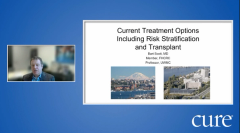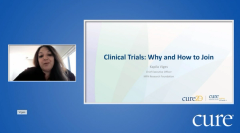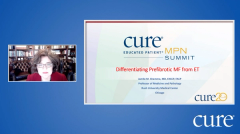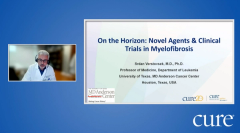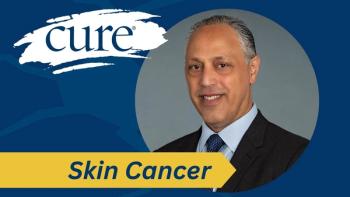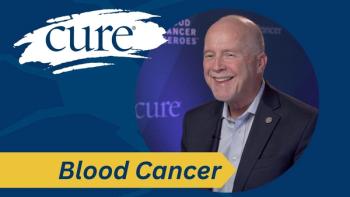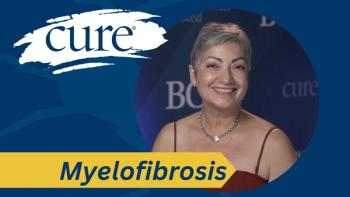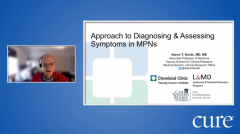
Educated Patient® MPN Summit Diagnoses and Treatment Panel: May 7, 2022
Watch Dr. Jamile Shammo, Dr. Aaron Gerds and Dr. Bart Scott, answer questions during the diagnoses and treatment panel during the CURE Educated Patient MPN Summit.
Episodes in this series

This panel was moderated by Dr. Jamile Shammo, and featured Dr. Aaron Gerds and Dr. Bart Scott.
Shammo: Dr. Scott, in the past, there was no treatment that was recommended, since it just addressed symptomatology in (myelofibrosis [MF]). So what is the research showing nowadays about earlier treatment and slowing progression to myelofibrosis?
Scott: Right, so most of that data would come from use of interferon therapy. And there is smaller studies what we call phase 2 trials, showing that the use of interferon can regress myelofibrosis. It also may cause molecular remission, but we don't yet know that this results in an improved survival. So that's an important point. And then if you look at the COMFORT trials, yes, there was improved survival with treatment with (Jakafi [ruxolitinib]), but that treatment was given for patients who had intermediate- to high-risk disease. And there's no evidence that treating lower-risk patients with myelofibrosis earlier with ruxolitinib, fedratinib or (Vonjo [pacritinib]), any of the “ibs”, no evidence that treating earlier improves overall survival. There is evidence that if patients need treatment, they have more intermediate-risk or high-risk disease that that can improve survival if they're treated with ruxolitinib.
Shammo: Thank you. And the next question is to that regard. I don't have any genetic mutation, and I have MF, can it still turn into acute leukemia.
Gerds: Yeah, certainly. So, these modern panels, these gene panels that we have, check 60, maybe even 100, or a couple 100 genes, right. So each of your cells has 60,000-plus genes in them. And so we're checking a very small part of the genome. And some of these tests look at specific spots within a gene, they may not look at the whole gene and its entirety too. So it's reasonable to think that for a lot of patients with quote unquote, triple-negative or myelofibrosis where we don't find the mutation, that there is a mutation somewhere that could lead to a disease evolving over time. It's just kind of unclear what that may be, and what kind of risk that is associated with.
Shammo: Thank you. The next question, I guess, either one could take this but this all right. Can you talk about iron deficiency anemia, I am on Jakafi and have had phlebotomy in three years. I'm assuming this is a PV patient, I'm now on iron supplements with a lot of fatigue, which is not like me. So what does iron deficiency do in someone who may be on Jakafi?
Scott: Right. So the development of fatigue is a complicated issue within the field of MPN. And there are multiple reasons why this could occur. And one of them is iron deficiency. So I didn't talk about this because of time. But when you place a patient on cytoreduction, one of the goals of that cytoreductive treatment is to make it so that patients don't need to receive phlebotomy anymore. And if you are able to successfully do that, you can consider replenishing iron, because iron deficiency can cause a high platelet count, which is not something you wanted somebody with implants already, it can cause fatigue, it can cause restless leg syndrome, and it can cause food pockets. So, in an ideal world, if you don't need to receive about anymore, and you're on site, a reductive treatment, it would be great to replenish the iron.
But patients may have continued fatigue, despite having adequate iron replacement. So one of the things that could be done is to assess the iron levels in an individual like this, and to make sure that they have had adequate iron restoration. And if that has occurred, then there may be other reasons for fatigue. And one of the things that can happen in patients with polycythemia vera is that they can progress to myelofibrosis, for instance. So persistent fatigue, despite replacement of iron, but indicate a progression of myelofibrosis. So that's just something to consider the differential.
Shammo: I agree with that. And I guess I know that that was talked about MPN symptom assessment score and how we address that. And I guess the question is, how do you figure the contribution of MPNs to the symptoms in someone who may have other comorbidities? So we always tend to be blamed and while patients have other comorbidities. How do you do that?
Gerds: Well, for a lot of patients that may be impossible to separate out, you know they’re different diseases, because unless you remove that disease from their body entirely, you'll never, never truly know. We can get some clues, right. So if we say, you know, for example, use a JAK inhibitor, which we would expect it to make some symptoms better. And we do see those symptoms improve after starting a JAK inhibitor, well, then we can attribute those symptoms, least that proportion of the symptom to the disease.
Likewise, when you stop a treatment and symptoms come back, that would also indicate that that is the source of that symptom. And to you know, you think about the other diseases and treating those. So again, if someone has sleep apnea, and that's contributing to fatigue, once they start on CPAP, or get one of those new sleep apnea, pacemaker type things, and their sleep apnea gets better, well, and then their fatigue gets better, well, then that was probably the sleep apnea, if they fix the sleep apnea, and their fatigue does not get better than that would suggest again, circling back to saying, well, maybe it was their MPN driving that symptom all along. So really, it's somewhat of a trial and error, in some instances, but it's really hard to separate those because they're all in inside of one person. And unless you can remove the disease completely, that there was a contributor completely, it's really hard to know.
Shammo: I totally agree. Next one, is there a direct causation between et and chronic migraine with aura?
Gerds: Oh, boy, I'll pick that one. Um, so again, you know, it does seem that there are increased risk of, or patients who are more likely to have headaches, whether they're ocular migraines or kind of classic migraine, there certainly is that association there. And, you know, it tends to be something where you have to attack from both angles. So you need to migraine-specific therapy, whether it's avoidance of triggers, you know, drugs like Imitrex, and that can help alleviate migraines, as well as you know, treating the ETs. So in ET, we will use things like aspirin for these micro vascular disturbances as well as lowering the count to try to improve those symptoms. So again, yes, they are related, they're connected. And often, though, we have to treat from both directions.
Shammo: I agree. And I think that speaks to your previous point that we have to it's sort of a trial and error that if you treat one entity and let's say someone's platelet count is optimized, and they continue to have migraine, well, then you have to treat the migraine etc.
The next one is for Dr. Scott, can we take medication break when we are on hydroxyurea for PV, and can we take some time off the medication to give our body a rest.
Scott: In general, I do not recommend that because of concerns about proliferation, and risk of thrombotic complications. Thrombosis is the leading cause of death of patients with polycythemia vera, and maintaining a hematocrit less than 45, a white count of less than 11,000 and a platelet count of less than 600,000 is an important component of that treatment. So I would say that if there are issues with administering hydroxyurea and patient is having symptoms from it, a better way to address that is to consider other types of therapeutic interventions. And Jakafi is FDA approved for patients that second-line therapy, if they fail, are intolerant to hydroxyurea, and as I mentioned, the proud PD trial showed a similar 12-month composite endpoint with CHR and spleen size reduction, comparing row pegylated interferon to hydroxyurea, so people have issues with hydroxyurea a better way to address that is considered different therapeutic treatments, rather than stop treatment.
Shammo: I agree totally. So why don't we get final thoughts from Dr. Gerds and Dr. Scott, before we wrap up, and then maybe we can go on break? Let's begin with Dr. Gerds.
Gerds: Thank you. Thank you very much again, you know, thanks for everyone for logging in. And, you know, learning more about your disease, you know, these things are incredibly complicated. And there's so many things that influence how an individual may feel and how their course may go. So, I think, you know, kind of the take home point here, everyone's course and journey may be different. And really developing a relationship with your care providers, your doctors and nurses and nurse practitioners is really important. That way for you, you get the best treatment possible based on what's going on with you at the time. So I know there's a lot of great talks going forward and new things to come. So I'm sure the rest of the talks will be very exciting.
Scott: Thank you. I want to thank all of the patients that have contributed to our understanding of this disease, and participation in a clinical trial is always an option for your care.
Raw transcriptions have been lightly edited for clarity.
For more news on cancer updates, research and education, don’t forget to

